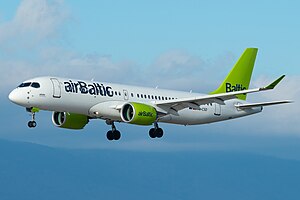The Airbus A220, formerly known as the Bombardier CSeries, is a family of narrow-body, twin-engine jet airliners designed and produced by Airbus. It consists of two models, the A220-100 and A220-300, which are designed to cater to the needs of airlines operating on regional and medium-range routes.
One of the notable features of the Airbus A220 is its fuel efficiency. The aircraft incorporates advanced aerodynamics and lightweight materials, such as composite materials and aluminum-lithium alloys, which reduce its weight and improve fuel efficiency. The A220 also features Pratt & Whitney PW1500G geared turbofan engines, which further enhance fuel efficiency and reduce noise levels.
The A220-100 has a seating capacity of approximately 100 to 135 passengers, while the A220-300 can accommodate around 130 to 160 passengers. Both models offer a spacious cabin with larger windows, allowing for more natural light and better views. The cabin is designed to provide a comfortable and enjoyable flying experience for passengers, with features such as wider seats, larger overhead bins, and reduced noise levels.
In terms of performance, the Airbus A220 has a maximum range of approximately 3,200 to 3,450 nautical miles (5,900 to 6,400 kilometers) and a cruising speed of around 460 knots (852 kilometers per hour). This allows it to operate on both short-haul and medium-haul routes, connecting passengers to a wide range of destinations.
The A220 has been well-received by airlines around the world. Its fuel efficiency, range, and passenger comfort make it a popular choice for airlines looking to optimize their operations and provide a superior travel experience. Additionally, its commonality with other Airbus aircraft allows for cost savings in terms of maintenance and training.
Overall, the Airbus A220 is a modern and efficient aircraft that meets the needs of airlines operating on regional and medium-range routes. Its fuel efficiency, range, and passenger comfort features make it a preferred choice for both airlines and passengers, offering a sustainable and enjoyable travel experience.

| Variant | A220-100 (BD-500-1A10) | A220-300 (BD-500-1A11) |
|---|---|---|
| Cockpit crew | 2 pilots | |
| Passengers | 100–120 (max 135) | 120–150 (max 160) |
| Seat pitch | 28–36 in (71–91 cm) in Y/J | 28–38 in (71–97 cm) in Y/J |
| Seat width | 18.5 to 20 in (47 to 51 cm) | |
| Cargo volume | 23.7 m3 (840 cu ft) | 31.6 m3 (1,120 cu ft) |
| Length | 35 m (115 ft) | 38.71 m (127 ft) |
| Wing | 35.1 m (115 ft) span, 112.3 m2 (1,209 sq ft) area (10.97 AR) | |
| Height | 11.5 m (38 ft) | |
| Fuselage diameter | 3.5 m (11 ft) | |
| Cabin | 3.28 m (10.8 ft) width, 2.11 m (6.9 ft) height | |
| Cabin length | 23.7 m (78 ft) | 27.5 m (90 ft) |
| MTOW | 63.1 t (139,000 lb) | 70.9 t (156,000 lb) |
| Maximum payload | 15.1 t (33,300 lb) | 18.7 t (41,200 lb) |
| OEW | 35.22 t (77,650 lb) | 37.08 t (81,750 lb) |
| Fuel capacity | 21,805 L (5,760 US gal) | 21,508 L (5,682 US gal) |
| Range | 3,450 nmi (6,390 km; 3,970 mi) | 3,600 nmi (6,700 km; 4,100 mi) |
| Cruise speed | Mach .82 (470 kn; 871 km/h; 541 mph) max., Mach .78 (447 kn; 829 km/h; 515 mph) typical |
|
| Takeoff distance (@ MTOW) | 1,500 m (4,800 ft) | 1,900 m (6,200 ft) |
| Landing distance (@ MLW) | 1,390 m (4,550 ft) | 1,510 m (4,950 ft) |
| Ceiling | 12,000 m (41,000 ft) | |
| Engines (2×) | Pratt & Whitney PW1500G | |
| Unit thrust | 84 to 104 kN (18,900 to 23,300 lbf) | 93 to 104 kN (21,000 to 23,300 lbf) |
| ICAO type | BCS1 | BCS3 |
